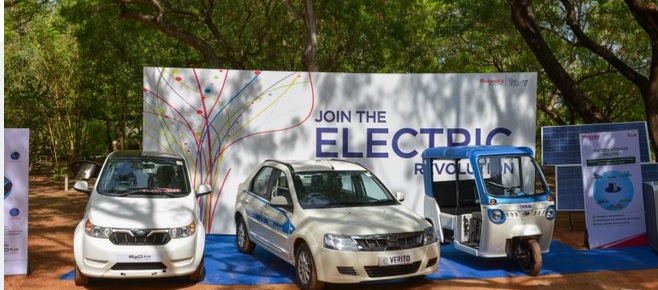Electrification kicks off in India
Back in 2015, India launched its FAME Scheme, or “Faster Adoption and Manufacturing of (Hybrid &) Electriv Vehicles. Where Phase 1 of the project was mainly aimed at tech development and manufacturing, FAME’s Phase 2 focuses on demand aggregation, adoption and market creation.
Incentives are an essential element of the FAME policies: USD 1.4 billion has been put aside to support consumers with the purchase of an EV (hybrid or full electric, 2/3/4 wheelers and buses included). The Indian Government has reduced the GST on EVs from 12% to 5%, introduced a tax deduction for the interest of EV car loans and introduced custom duty exemptions on certain EV parts to reduce the production cost.
Despite the strategy and the subventions, the uptake of EVs is unfortunately very low. Less than 2000 EV cars were purchased and about 300.000 electric 2/3 wheelers under the FAME scheme. Big absolute numbers, but not for a country that counts 1.4 billion people; the current EV penetration across the various form factors is only 1% of total vehicle sales.
Public Transit
India understood the importance of electrifying public transport and has implemented public-private collaborations to accelerate penetration. State Governments are heavily supporting the country objectives by ordering and budgeting for electrification. The state of Karnataka, for instance, is purchasing 40 electric buses, 100 4-wheelers and 500 3-wheelers to be deployed in its capital and tech-hub Bengaluru. Another example is the first inter-city electric bus that covers the transit between Mumbai and Pune – an extremely important 150 km connection for the State of Maharashtra, linking its 2 biggest cities.
In conjunction with the electrification of public transit, India is pushing the transit from petrol to CNG, in order to reduce its dependency on oil products.
Indian Manufacturers
No one understand the needs of the Indian consumer better than the Indian OEMs. The 3 major car makers in India are Maruti Suzuki, Tata and Mahindra & Mahindra. All of them are looking into EVs that have a form factor that fits the market. India is not interested in large powerful sedans or big SUVs; the consumer likes small cars, as the budgets are limited, and the streets are crowded.
Maruti Suzuki will be launching the WagonR Electric. The WagonR is a boxy small vehicle, categorized as a kei-car in Japan (small vehicles that benefit from lower tax rates) that has been successful in its ICE version in India. The EV will be sold at around USD 14.000 according to Maruti Suzuki.
Mahindra has a few EVs on offer: the eVerito small sedan, the eSupro van and the Treo rickshaw. The next generation of its small electric hatchback e2o, which receives the suffix “NXT” to distinguish it from its predecessor. Pricing is announced to be between USD 10.000 and USD 15.000 according to autoportal.com, a popular Indian car website.
Tata is looking a bit more upmarket with its Nexon EV, a compact SUV. It’s the better-looking car amongst the Indian offering and could potentially attract a younger urban clientele. The car comes at a substantial price of USD 18.600, but this includes a home charger.
Charging Infrastructure
The current infrastructure is insufficient to reassure EV candidates. In addition, most of the affordable EVs have a short range which makes them unpractical. Central Government aims to have one charging station at every 4 kilometers in the bigger cities (above 1 million population) and has awarded a deal for 2600 chargers to state-run companies a few weeks ago. Here as well, the FAME scheme acts as a facilitator for the finance part of the award.
Important first steps
The Indian Government targets 30% adoption of EVs by 2030. Even if 2019 was not a success in terms of penetration of EV sales, a lot of first steps have been taken and uptake from the industry is clearly present. The next step will be to reassure the Indian consumer that EVs can be a real alternative to ICE vehicles (infrastructure, subsidization), perhaps discouraging measures for ICE cars (taxation) and the adoption of electric vehicles for public transport, taxi and ride-hailing in all its form factors (buses, cars and rikshaws).
Source: https://www.globalfleet.com
FLEET MANAGEMENT NEWSLETTER
Join to our NEWSLETTER; you’ll get the latest news, articles, publications, training, conferences, events, congresses, and white papers related to Fleet Management, Mobility and Automotive IN your email fortnightly.




